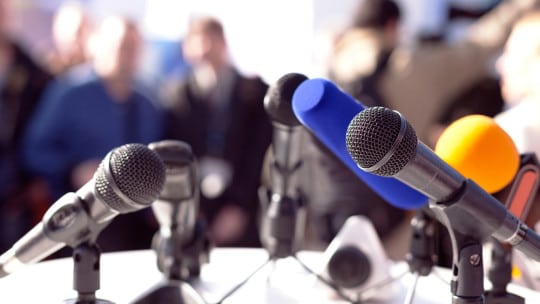
In this world of always-on, 24-7 news cycles, some of the basics of PR can seem passé and old school. Yet when journalists are asked in surveys what they want from PR professionals, the basics often come out on top: timely news and other assets (photos, video clips) that are useful to the journalist’s readers, interview opportunities with important players and prompt responses to follow-up questions about the pitched topic. Social media/digital technology can handle all this, of course, but there's nothing like a face-to-face meeting or interview to establish a relationship with a journalist. And as social media influencer Brian Fanzo says, "Social media was not built to replace a handshake."
Enter the media tour, one way to get your brand’s story and its executives in front of journalists in multiple locations.
Several themes emerged when we asked PR pros to provide nuts-and-bolts tips and must-haves for conducting media tours today.
All our pros urged communicators to do as much planning as possible. In other words details, details, details. Ned Barnett (photo, left, below), fellow, PR and marketing, the American Hospital Association, prepares a backgrounder that includes the company’s narrative, the executives’ personal background, reproducible graphic images–logos plus head-and-shoulder shots of the executives, at a minimum–and a summary of why the media tour is taking place.

In addition he urges PR pros to have printed press-kits or product-intro hand-outs, but always also have them stored in a thumb drive, preferably monogrammed with the brand’s logo. Another tip: use high-capacity thumb drives, 64 gigs at least – or as big as possible. “Do this because the editor or reporter you meet with is more likely to keep something like that if it has real utility, hence the high capacity and the branding logo.”
Our trio also stressed, though, all planning aside, something will go wrong. As a result, the ability to be flexible is paramount. Anthony DeAngelo (photo, right), senior director, media relations, APCO Worldwide, likes to chart a media tour's goals in advance. That way when something goes wrong, he can remain focused on what he needs to be successful. “Something will go wrong,” he promises, “but take it in stride and remember that the headlines are what counts.”
paramount. Anthony DeAngelo (photo, right), senior director, media relations, APCO Worldwide, likes to chart a media tour's goals in advance. That way when something goes wrong, he can remain focused on what he needs to be successful. “Something will go wrong,” he promises, “but take it in stride and remember that the headlines are what counts.”
 Last, but certainly not least, remember what we mentioned at the top about providing useful news. As Stacey Sayer (photo, left), global media head at Advanced Energy, told us, “Think storyline first.” The story behind the media tour, she says, needs to be “a direct value-add for journalists and their readers.” When pitching a media tour interview avoid leading with a veiled sales pitch. Instead, Sayer says, tell the journalist “what problems you’re aiming to solve and how your solutions tie to major industry trends or challenges.”
Last, but certainly not least, remember what we mentioned at the top about providing useful news. As Stacey Sayer (photo, left), global media head at Advanced Energy, told us, “Think storyline first.” The story behind the media tour, she says, needs to be “a direct value-add for journalists and their readers.” When pitching a media tour interview avoid leading with a veiled sales pitch. Instead, Sayer says, tell the journalist “what problems you’re aiming to solve and how your solutions tie to major industry trends or challenges.”
Below are edited versions of other tips they offered:
DeAngelo
- Go in with a goal, and stick to it. It’s tempting to try to get too much from reporters during a media tour. Know the headlines you want, and build toward them.
- Diversify your offer to reporters. Give them options of executives to talk to, visuals to capture and how to capture them. Understand that reporters are expected to deliver across mediums, so prepare for that and provide the assets they need.
Sayer
- Avoid over-packing the tour schedule to the point where you can’t make time to meet with an important journalist later in the day, if that better accommodates his / her schedule.
- Do your homework. Familiarize yourself with the reporters you are scheduled to speak with. Take a look at previous articles (especially their most recent) and get a sense of their interests and stances. And know the reporters’ outlets. Take time to understand publications’ audiences and know how your story relates to the needs of its readers.
- Don’t be afraid to let a reporter know that you don’t have the answer to a question. Honesty is the best policy, and it’s better to take this route vs. risking a response that could be incorrect or contradict messaging.
Barnett
- Always have something new to say to the media, such as a new product, or the results of an online survey. Never conduct a media tour for the sake of doing a media tour.
- Consider kicking off a media tour with a press conference, especially if you have time-sensitive news. Any even tangentially-national news story that touches on the government should be launched with a press conference at the National Press Club in Washington. Any Silicon Valley-like tech story should begin with a press conference in San Jose or San Francisco.
- Regardless of your primary media targets, while in a major metro area always try to schedule interviews on satellite radio and cable news, which means having a generic hook as well as a more focused one.
- Always have a senior PR expert accompany your executive to handle on-site arrangements, to prep the executive before each meeting and debrief her after each media interview and to fix gaffes when they happen, which they always do.
- Have a PR pro back in the office to handle last-minute bookings of new interviews.
- Budget permitting, avoid cabs and hire a car service to focus on your transportation.
- Integrate a virtual media tour for those who are outside your travel destinations. Their failure to be on your itinerary doesn’t diminish their value to your brand. A virtual tour should come immediately after the real tour. If you have a choice avoid having the executive bouncing between the two media tours.
- Follow up interviews immediately with a note. Provide additional information requested, mention key talking points from the interview and, most important, say thank you! Use a digital recorder to dictate your note if your schedule is too busy. The follow-up must be done within 24 hours or you’ll look hopelessly bush league.
Seth Arenstein is editor of PR News. Follow him: @skarenstein
